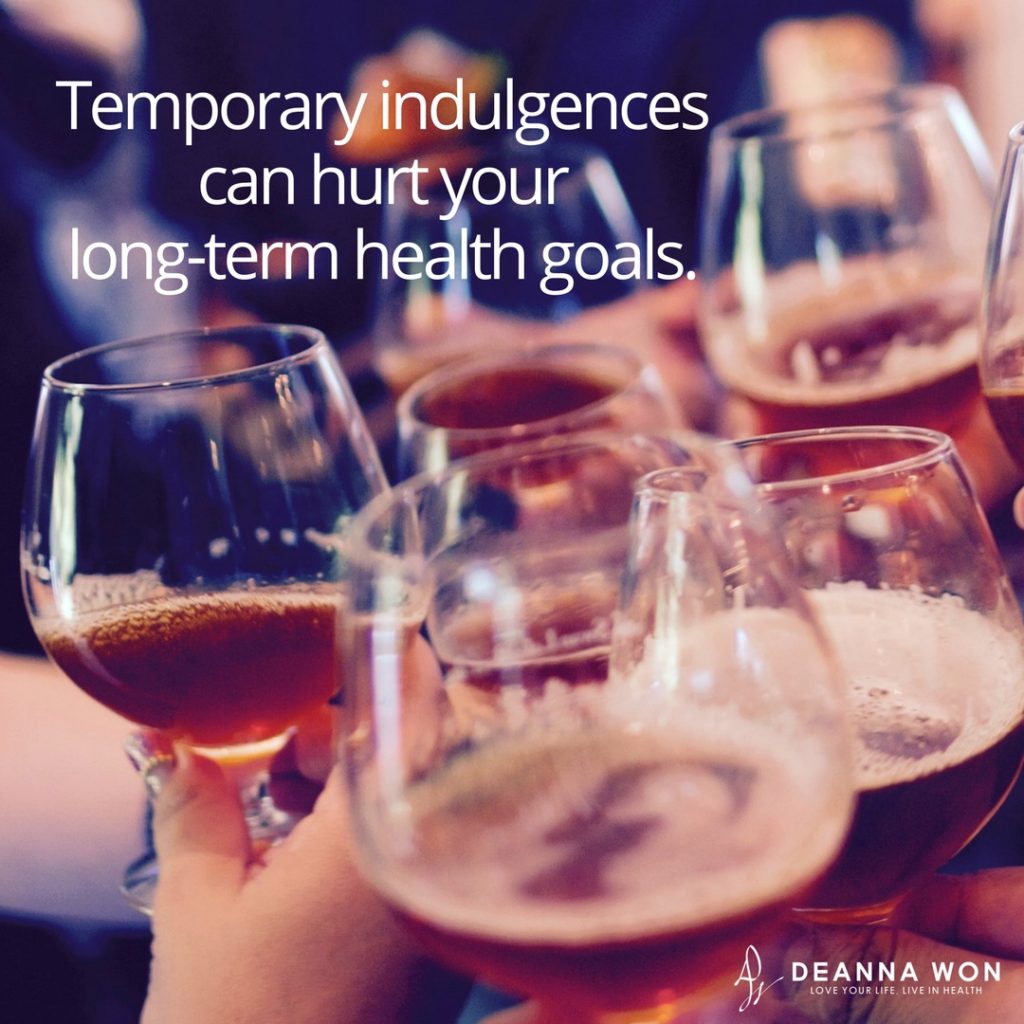With the Christmas holiday season upon us, many are spending more time with friends and family, with the many dinners and parties to attend. While we’re given the opportunity to bond with those whom we haven’t seen in a while, there’s a tendency to eat more food that typically isn’t part of our daily diet. Perhaps we may toast with our family, friends, with glasses of wine, beer, and champagne in hand.
Drinking has been a part of celebrations throughout history. Even Jesus turned water into wine at a party back in biblical times. It’s become part of the dining out experience, hanging out with friends, or even a way for people to unwind after a hard day at work. So, for many, imbibing during the holidays and other festivities goes hand-in-hand with the socializing and fellowship experience.
However, as we continue to educate ourselves about how our health is affected by dietary decisions, it’s important that we’re choosing the best options to keep healthy, even in celebratory times. Although that glass of wine or beer may be tempting, you may want to be aware of how alcohol can increase your risk of cancer, prohibit your body from absorbing vital nutrients, and can increase your waistline, which can lead to other health problems down the line. Although some report that moderate alcohol consumption may be beneficial to heart health, it’s best to weigh the pros and cons when making dietary decisions that may affect your long-term health goals.
How does alcohol consumption increase your risk of cancer?
There are two chemicals in alcohol that can change your DNA – ethanol and acetaldehyde. Ethanol is the primary component of alcoholic beverages. Although ethanol, on its own, has not been proven to be carcinogenic, how it converts in the body is. When ethanol is consumed, the body processes it through oxidation and turns it into acetaldehyde. In this form, acetaldehyde is both carcinogenic and mutagenic as it now is capable of binding to DNA and protein. A review by the Journal of Clinical Oncology indicates that “in animal models, administration of ethanol or acetaldehyde in drinking water increased the incidence of various tumors in mice and rats.”
The World Health Organization has classified alcohol as a Class 1 carcinogen as it has been found to cause cancer in humans. Specifically, IARC (International Agency for Research on Cancer) concluded that “there is sufficient evidence in humans for the carcinogenicity not only of alcohol consumption but also for the carcinogenicity of acetaldehyde associated with alcoholic beverage consumption.” There is also increasing evidence that some people may be genetically predisposed to increased risks of alcohol-related cancers. In most cases, the acetaldehyde created by the body with ethanol metabolization is eliminated from the body by aldehyde dehydrogenase-2 (ALDH2). However, some people have a genetic variant of ALDH2 that allows the body to accumulate excessive amounts of acetaldehyde, which then leads to an increased opportunity for toxic, mutagenic effects and increase the susceptibility to alcohol-related cancers. East Asian populations are more likely to carry this genetic variant of ALDH2. Several studies on this population have noted that “alcohol drinking is more strongly associated with cancers of the upper aerodigestive tract among those with a high-risk genotype.”
Your oral bacteria may also play a role in how acetaldehyde is produced in the body. Poor dental health and oral hygiene can cause an increase of bad bacteria in the mouth. The increased oral bacteria can lead to increased salivary acetaldehyde production with alcohol consumption.
For those who smoke when they drink, the production of salivary acetaldehyde is greatly increased. According to a 2006 study, “smokers have twice as much acetaldehyde in their saliva as nonsmokers, if they consume the same amounts of alcohol. Smoking approximately 20 cigarettes daily increases in-vitro salivary acetaldehyde by about 50 percent following alcohol consumption.”
Your fecal bacteria also play a role in the production of acetaldehyde. According to the Department of Alcohol Research at the National Public Health Institute in Helsinki, Finland, “of all the tissues in the body, the mucosa in the colon contains the greatest amount of acetaldehyde per gram of tissue following alcohol ingestion.” In the colon mucosa, acetaldehyde can excessively increase cell growth which is associated with an increased cancer risk. This risk also increases with age, “possibly because the sensitivity of the colon mucosa to acetaldehyde increases with age. This may have practical implications, as age alone is a risk factor for colorectal cancer.”
Additionally, acetaldehyde can elevate estrogen levels, thereby creating “estrogen dominance,” a term coined by the late Dr. John Lee indicating the relative imbalance between progesterone and estrogen. Increased estrogen levels can lead to weight gain and increase the risk for breast, ovarian and uterine cancers. According to an NCBI publication, “Several epidemiologic studies have shown that alcohol was more strongly associated with hormone-receptor-positive breast tumors than with other types of breast cancer, consistent with an underlying hormonal basis for the association between alcohol intake and breast cancer.”
Overall, alcohol consumption is associated with an increased risk of mouth, throat, larynx, liver, esophageal, breast and colorectal cancers. No matter the type of alcohol–whether it be beer, wine or liquor, doesn’t change the risk.
How does alcohol consumption weaken nutrient absorption?
We get energy through the metabolization of the food we eat. In the metabolic process, our bodies absorb nutrients from food to generate the energy needed to keep all the organs functioning. Alcohol, however, can prohibit this process.
With alcohol consumption, nutrients are not broken down into usable energy because it decreases the secretion of pancreatic enzymes and damages the lining of the stomach and intestines, which prevent the absorption and transportation of the nutrients into the blood. Additionally, it prevents the absorption of thiamin (vitamin B1), vitamin B12, folic acid, and zinc. According to Gina Firth, Director of Alcohol and Drug Education and Luis G. Manzo, Ph. D, Staff Psychologist and Coordinator of Alcohol and Other Drug Treatment Services, both from the University Counseling Center of Notre Dame, “Even if nutrients are digested and absorbed, alcohol can prevent them from being fully utilized by altering their transport, storage, and excretion. Decreased liver stores of vitamins, such as vitamin A, and increased excretion of nutrients, such as fat, indicate impaired utilization of nutrients by alcoholics.”
If your body isn’t able to receive proper nutrients, it will become nutritionally deficient, which can lead to deterioration of your body, along with your mind. Those with nutritional deficiencies may experience chronic fatigue, memory loss, skin disorders, digestive issues, and even blindness. For those who have attended my recent live lectures, you will know that nutritional deficiency is one of the main causes, along with toxicity, that leads to chronic health issues and disease conditions.
How does alcohol consumption cause weight gain?
There is no nutritional value in alcoholic beverages, which only has empty calories that can quickly add up, causing you to exceed your daily caloric intake. Weight gain can also be a result of acetaldehyde-related elevated estrogen levels, which cause an increase of abdominal fat (beer belly) and may even cause gynecomastia, or breast enlargement in men, which is commonly known as “man-boobs.”
Besides the body creating acetaldehyde from alcohol consumption, the body can also produce reactive oxygen species (ROS) or free radicals. When an imbalance exists between antioxidants and free radicals in the body, oxidative stress can occur, which leads to inflammation. Inflammation, a precursor to a number of diseases, can also cause weight gain. A 2008 U.K. study showed that during a 9-year period, “an increase in weight is associated with an increase in systemic inflammation. This provides a mechanism that may explain some of the previously reported association of weight gain with an increased risk of both cancer and cardiovascular disease.”
Many nutritional experts advise their clients to cut out alcohol when they are attempting to lose weight for these reasons. Because it adds unusable calories to your daily intake, increases your estrogen levels, and causes inflammation, consuming alcoholic beverages may inhibit any potential weight loss goals that you may have.
What about the health benefits of consuming alcohol?
Although I’m not a proponent of alcohol consumption, some studies have shown that moderate drinking may contribute to cardiovascular health. Benefits of moderate drinking include decreased risk of heart disease, mortality due to heart disease, ischemic stroke, and diabetes. Some note that this is due to the polyphenol (antioxidant) resveratrol, which is found in red wine. However, you can get this through consuming grapes, without the harmful effects of alcohol.
Other studies have actually suggested that ethanol, which is found in all types of alcohol, may be a heart-protective agent. A 2013 study, published by the American Heart Association, suggests that “ethanol was the acting agent in the later study accountable for improvements in both vascular ingrowth and microvascular function through improved smooth muscle reactivity, as both endothelial-dependent and endothelial-independent microvascular reactivity were improved in the current study with ethanol in the absence of concomitant polyphenols, such as resveratrol, found in red wine.”
On the other hand, the Journal of Clinical Oncology states that “larger studies and meta-analyses have failed to show an all-cause mortality benefit for low-volume alcohol use compared with abstinence or intermittent use, which suggests the lack of a true benefit to daily alcohol use.” With this statement, they have concluded that “the benefit of alcohol consumption on cardiovascular health likely has been overstated. As reviewed in the Magnitude of the Association section, the risk of cancer is increased even with low levels of alcohol consumption, so the net effect of alcohol is harmful. Thus, alcohol consumption should not be recommended to prevent cardiovascular disease or all-cause mortality.”
Even if these benefits exist, it is not recommended that non-drinkers begin to consume alcohol to improve cardiovascular health. It is also not recommended that drinkers increase their alcohol intake. As a Class 1 carcinogen, alcohol still has the capability of increasing your cancer risk as well as affecting your hormones and increasing your body fat.
Moderate alcoholic drinking is defined as up to two drinks for adult men and one drink for adult women. Per the Dietary Guidelines, “One alcoholic drink-equivalent is described as containing 14 g (0.6 fl oz) of pure alcohol. The following are reference beverages that are one alcoholic drink-equivalent: 12 fluid ounces of regular beer (5% alcohol), 5 fluid ounces of wine (12% alcohol), or 1.5 fluid ounces of 80 proof distilled spirits (40% alcohol).”
We all want to enjoy the holidays with family and friends. While you’re in the midst of your social events and gatherings, keep in mind that sometimes temporary indulgences may get in the way of your long-term health goals. If you choose to drink alcohol, moderation is key and it may be a good idea to drink a glass of water with every alcoholic drink. You may also want to consider detoxing your system after the holidays to start your new year off in a healthy way.
We all want to live our lives to the fullest, each and every day, celebrating with those we love. Let’s keep our health in mind so that we can enjoy and feel our best during these special moments.
Ready to make your health a priority? Contact me here to schedule your consultation.
Sources:
http://ajcn.nutrition.org/content/87/1/30.full
http://ascopubs.org/doi/full/10.1200/JCO.2017.76.1155
http://circ.ahajournals.org/content/circulationaha/128/11_suppl_1/S136.full.pdf
https://health.gov/dietaryguidelines/2015/guidelines/appendix-9/
https://pubs.niaaa.nih.gov/publications/aa22.htm
https://thetruthaboutcancer.com/high-estrogen-levels/
https://wellness.ucsd.edu/studenthealth/resources/health-topics/alcohol-drugs/Pages/alcohol-nutrition-endurance.aspx
https://www.cancer.net/navigating-cancer-care/prevention-and-healthy-living/alcohol
https://www.cancer.org/cancer/cancer-causes/diet-physical-activity/alcohol-use-and-cancer.html
https://www.ncbi.nlm.nih.gov/pmc/articles/PMC3860434/
https://www.ncbi.nlm.nih.gov/pmc/articles/PMC4299758/
https://www.ncbi.nlm.nih.gov/pubmed/21772329
https://www.ncbi.nlm.nih.gov/pubmed/8904969
https://www.niaaa.nih.gov/alcohol-health/overview-alcohol-consumption/alcohol-facts-and-statistics
https://www.healthline.com/health/malnutrition#types

